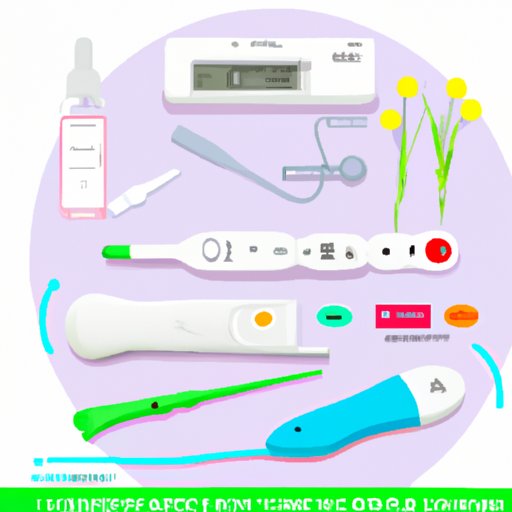Introduction
Ovulation is the process of releasing a mature egg from the ovary. It usually occurs about 14 days before the start of a woman’s next menstrual cycle, although this can vary from person to person. Knowing when you’re ovulating can help you plan for pregnancy or avoid it, depending on your goals. Here are 8 easy ways to tell if you’re ovulating.
Monitor Your Basal Body Temperature (BBT)
Your basal body temperature (BBT) is your temperature when you first wake up in the morning. To measure your BBT, use a special thermometer that you can buy at most pharmacies. Take your temperature every morning before you get out of bed and record it in a chart. After several days, you should see an increase in your temperature of about 0.4-1.0°F (0.2-0.6°C). This indicates that you are ovulating.
“The best way to track your ovulation is by taking your basal body temperature (BBT) every day with a basal thermometer,” says Dr. Sherry Ross, OB/GYN and Women’s Health Expert at Providence Saint John’s Health Center in Santa Monica, California. “An increase in temperature indicates that ovulation has occurred.”
Track Changes in Cervical Mucus
Cervical mucus is fluid produced by the cervix. During ovulation, the amount of cervical mucus increases and becomes thinner, clearer, and more slippery. To observe changes in your cervical mucus, you can check your underwear throughout the day or wipe yourself with toilet paper after going to the bathroom. The presence of thin, clear, slippery mucus indicates that you are ovulating.
“Checking your cervical mucus is another way to determine when you’re ovulating,” says Dr. Ross. “When your body is preparing to release an egg, the mucus will become thin, clear, and stretchy like raw egg whites.”

Pay Attention to Ovulation Pain
Ovulation pain, also known as mittelschmerz, is a sharp or dull pain in the lower abdomen that some women experience during ovulation. This pain can last anywhere from a few minutes to a few hours. Paying attention to ovulation pain can be a good indicator that you are ovulating.
“Some women may experience a mild twinge of pain in their lower abdomen when they ovulate,” says Dr. Ross. “This is called mittelschmerz and is usually a sign that ovulation is occurring.”

Note Changes in Cervical Position
Your cervix is the opening to your uterus. During ovulation, the cervix rises higher and softens, making it easier for sperm to enter the uterus and fertilize an egg. To observe changes in your cervical position, insert a clean finger into your vagina and feel for any changes. A high, soft cervix indicates that you are ovulating.
“You can check your cervical position at home by inserting a clean finger into your vagina and feeling for any changes,” says Dr. Ross. “A high, soft cervix indicates that you are ovulating.”

Look Out for Breast Tenderness
Some women experience breast tenderness during ovulation. This can include swelling, sensitivity, and soreness. Paying attention to changes in your breast can be a good indicator that you are ovulating.
“Breast tenderness is another common symptom of ovulation,” says Dr. Ross. “It’s important to be aware of any changes in your breasts that could indicate that you are ovulating.”
Keep an Eye on Your Libido
Libido, or sex drive, can be affected by hormones such as estrogen and testosterone. During ovulation, the levels of these hormones increase, which can lead to an increase in libido. Paying attention to changes in your libido can be a good indicator that you are ovulating.
“An increase in libido is another sign that you are ovulating,” says Dr. Ross. “Being aware of changes in your sex drive can help you determine when you’re fertile.”
Use an Ovulation Predictor Kit
Ovulation predictor kits are available at most pharmacies and consist of strips that detect the presence of luteinizing hormone (LH) in your urine. LH is released in large quantities just before ovulation, so a positive result on an ovulation predictor kit indicates that you are about to ovulate.
“Ovulation predictor kits are a great tool for determining when you’re ovulating,” says Dr. Ross. “These kits test for the presence of luteinizing hormone (LH) in your urine, which is released in large quantities just before ovulation.”
Conclusion
By monitoring your basal body temperature, tracking changes in cervical mucus, paying attention to ovulation pain, noting changes in cervical position, looking out for breast tenderness, keeping an eye on your libido, and using an ovulation predictor kit, you can easily tell when you are ovulating. Knowing when you are ovulating can help you achieve your fertility goals.
Remember, it is important to consult with your doctor if you have any questions or concerns about your fertility. With the right knowledge and tools, you can take charge of your reproductive health.
(Note: Is this article not meeting your expectations? Do you have knowledge or insights to share? Unlock new opportunities and expand your reach by joining our authors team. Click Registration to join us and share your expertise with our readers.)
